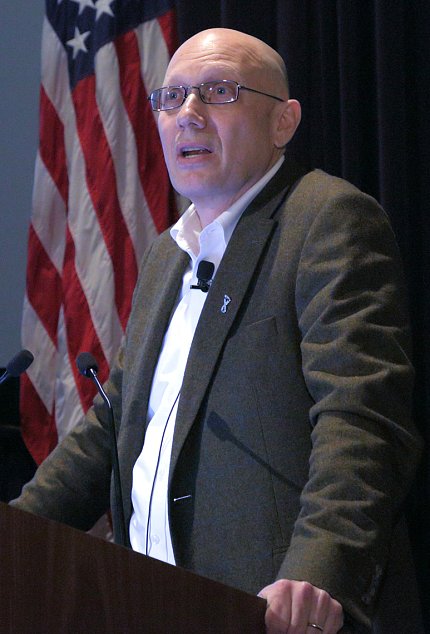Studying Suicide
Is It Ethical to Enroll Suicidal Patients in Clinical Research?

Photo: Bill Branson
Selecting volunteers for any clinical study requires great discretion. For patients with dire medical conditions, research trials offer hope for restored health and new treatments. But what happens when the volunteers are in active crisis? How do we help and protect patients with suicidal thoughts who are at risk for life-threatening behaviors? Is it ethical to enroll such patients?
This dilemma was discussed at Bioethics Grand Rounds on Feb. 3 in Lipsett Amphitheater.
“I don’t think it’s responsible to talk about this kind of research without considering the possibility that by studying individuals who have recently been suicidal, there will be a suicide attempt or completed suicide here in the hospital [during the study],” said discussant Dr. Donald Rosenstein, director of the Comprehensive Cancer Support Program and vice chair, division of hospital psychiatry, at the University of North Carolina, Chapel Hill.
Suicide has become the leading cause of injury-related death in the U.S. More than 40,000 Americans kill themselves every year and, equally troubling, this rate has remained stable for more than 5 decades. But research is lacking in this field, especially on people actively considering or having recently attempted suicide. Instead, most studies have evaluated patients who have made at least one suicide attempt at some time in their lives, possibly many years ago.
“Suicidal patients often are excluded from our psychiatric research,” said Dr. Elizabeth Ballard, a clinical psychologist and research fellow in NIMH’s Experimental Therapeutics and Pathophysiology Branch.
“In fact, depression clinical trials are getting more restrictive,” said Ballard. “Very few are working with people who are currently experiencing suicidal thoughts.”

Photo: Bill Branson
That’s precisely the group Ballard and her team is recruiting in a current neurobiology of suicide protocol. The study evaluates four research groups, the most acute of which consists of people who have seriously considered or attempted suicide in the past 2 weeks. All groups will undergo neurological imaging and psychological evaluations; the acute group also will receive the drug ketamine, an anesthetic believed to have a fast antidepressant effect and the potential to rapidly reduce suicidal thoughts.
In this study, patients can continue taking their current medications but may have a delay in starting new antidepressants for 1-2 weeks. The investigators are careful not to call this a treatment trial, said Ballard, since ketamine is not yet FDA-approved for depression. Therefore, without the prospect of clinical benefit, she posited, is it ethical to enroll patients who are actively in crisis?
Before recruiting patients for this protocol, investigators consulted with the Clinical Center’s department of bioethics for more than a year to identify potential risks and safeguards and participated in an intensive institutional review board assessment. Getting the green light to study people currently thinking about suicide sets this study apart, said Ballard, from the many studies that don’t include actively suicidal patients.
Rosenstein, also a former NIMH clinical director and IRB chair, said it’s not only ethical, but also necessary, to study at-risk patients and better understand suicide. This protocol, he said, has social value, fair subject selection, independent medical monitors, proper scientific methodology and a favorable risk-benefit ratio. The NIMH study also builds in such safeguards as a secure inpatient setting, a clinical research advocate from the human subjects protection unit, specialized staff training and a detailed informed consent process.
“After being [at NIH] for 18 years right out of training, I felt like when I landed back at an academic center, it was almost unrecognizable from how inpatient clinical care had been practiced when I was a resident,” said Rosenstein. “There was a time when someone who was severely depressed, with or without suicidality, would be hospitalized for a month with a genuine, in-depth effort to understand how they got there and really to do some intensive inpatient work. Now it’s very often a matter of people being hospitalized only when they’re suicidal and only for as long as they’re actively suicidal. The comparison between the care provided in this research protocol and standard care is not even close in many respects.”

Photo: Bill Branson
And, Rosenstein said, the conditions that carry increased risk of suicide make it all the more important to study. “You need to take a giant step back and ask how is suicidal behavior different from so many other conditions that we study at the NIH, which are very serious conditions associated with substantial morbidity and mortality.”
While he finds great value in this research protocol, Rosenstein said he hopes it will pave the way for more studies that include patients with comorbid substance abuse problems and medical illnesses that can make them prone to highly lethal behaviors.
“I do not think that the research risks of this protocol are particularly high,” said Rosenstein, “certainly compared to the risks associated with having a condition that renders you suicidal or some of the risks associated with usual care, which quite honestly often keep me up at night because of how many poor disposition options we have.”
In the NIMH protocol, subjects must score at least 90 percent on a consent quiz, indicating they understand their decision to enroll. If a patient opts to leave the study and is deemed high risk, the patient may have to be transferred or committed; in that regard, it complicates the voluntary component of research like this, Rosenstein said. For those who complete the study, follow-up assessment and care may be needed. “We know discharge from hospitals is a critical time for acute suicide risk,” said Ballard.
It’s important to recognize that many suicidal patients, even in trials, might not admit the severity of their situation. “We have to have a lot of humility about what we can take from either a structured interview or a clinical review,” said Rosenstein. In one study of 100 inpatient suicides, he said, 78 of the patients said they were not suicidal, then went on to kill themselves.
“If we could know more about this suicidal state,” said Ballard, “maybe we could develop better, more effective treatments.”
